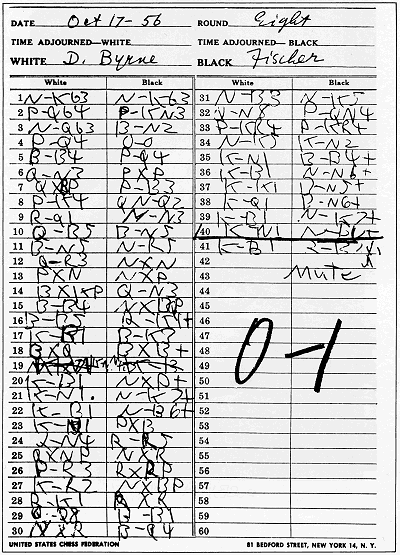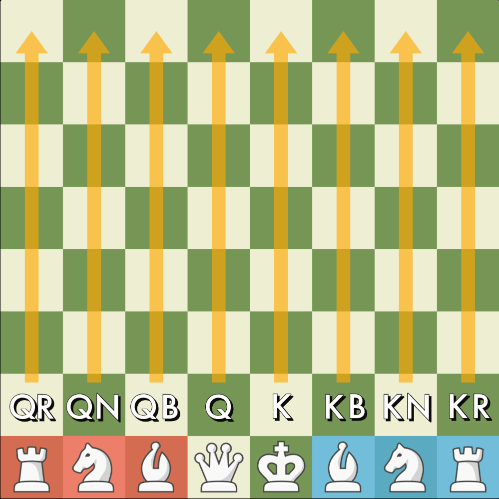
How to Read Descriptive Notation
NOTE: This article assumes you're already proficient with algebraic notation. If you're not, then check out this excellent guide before continuing: Chess Notation.
Intro
Today, the chess community uses algebraic notation exclusively. Why, then, should we bother learning descriptive notation?
Historically, descriptive notation was the standard. Do you have an old chess book collecting dust on the shelf? Do you want to follow an original game scoresheet from Bobby Fischer?
If you can't read descriptive notation, you're missing out on a wealth of chess knowledge and history!

Overview
We can boil descriptive notation down to the following:
![]() Castling (if applicable, end here); otherwise:
Castling (if applicable, end here); otherwise:
![]() Capture (if applicable) +
Capture (if applicable) +
![]() Special action (if applicable).
Special action (if applicable).
Let's walk through each variable step-by-step. At the end, we'll notate a complete game to reinforce the concepts and test our knowledge.
 Castling
Castling
We notate castling the same way as in algebraic notation: 0-0 for kingside (short castle) and 0-0-0 for queenside (long castle). You may also see 'castles' written out in some chess books, but this is self explanatory.
 Piece Abbreviation
Piece Abbreviation
| Piece | Abbreviation |
| Pawn |
P |
| Knight |
N or Kt |
| Bishop |
B |
| Rook |
R |
| Queen |
Q |
| King |
K |
There are two important things to note:
![]() Unlike algebraic notation, we notate the abbreviation for pawn 'P'.
Unlike algebraic notation, we notate the abbreviation for pawn 'P'.
![]() The abbreviation for knight is sometimes 'Kt'. The chess community eventually dropped 'Kt' in favor of 'N' to avoid confusion with the king.
The abbreviation for knight is sometimes 'Kt'. The chess community eventually dropped 'Kt' in favor of 'N' to avoid confusion with the king.
 Capture
Capture
If there's a capture, we notate 'X' after the piece abbreviation. Otherwise, we notate hyphen '-' after the piece abbreviation. Easy enough so far!
 Coordinates
Coordinates
The coordinates on the chess board are still comprised of files and ranks.
Files
Instead of A to H, the name of each file is based on the first rank piece in the starting position.

Of course, it's necessary to differentiate between the pairs of pieces. In the diagram below, the pieces on the kingside (in blue) are the king's bishop, king's knight, and king's rook. The pieces on the queenside (in red) are the queen's bishop, queen's knight, and queen's rook. Therefore, we name the files using the following abbreviations:

Ranks
The ranks are the trickiest part because they change based on which color is to move. It is white to move in the diagram below, so the ranks are the same as algebraic notation.

Now it is black to move in the diagram below, so the ranks are reversed!

To illustrate this concept, consider the position below. How would you record these moves in descriptive notation?

That's right! 1. P-Q4 P-Q4. If you understand this, then you’re well on your way to mastering descriptive notation!
 Special Action
Special Action
Finally, we notate the “special actions” as follows:
| Special Action |
Descriptive Notation |
| pawn promotion | parentheses, for example: P-K8(Q) |
| en passant | e.p. |
| check | ch or + |
| checkmate | mate or ++ |
| resigns | resigns |
| draw | draw |
Best by Test
Now that we have the essentials down, let's notate the "Game of the Century!"
| Tom Shupe, founder of MVP Chess and Chess.com Coach of the Month, is an active tournament player with a peak USCF rating of 2025. An award-winning writer, his work has been published in print by American Chess Magazine and online by Chess.com. Follow his chess insights and streams on Twitch and YouTube. |
